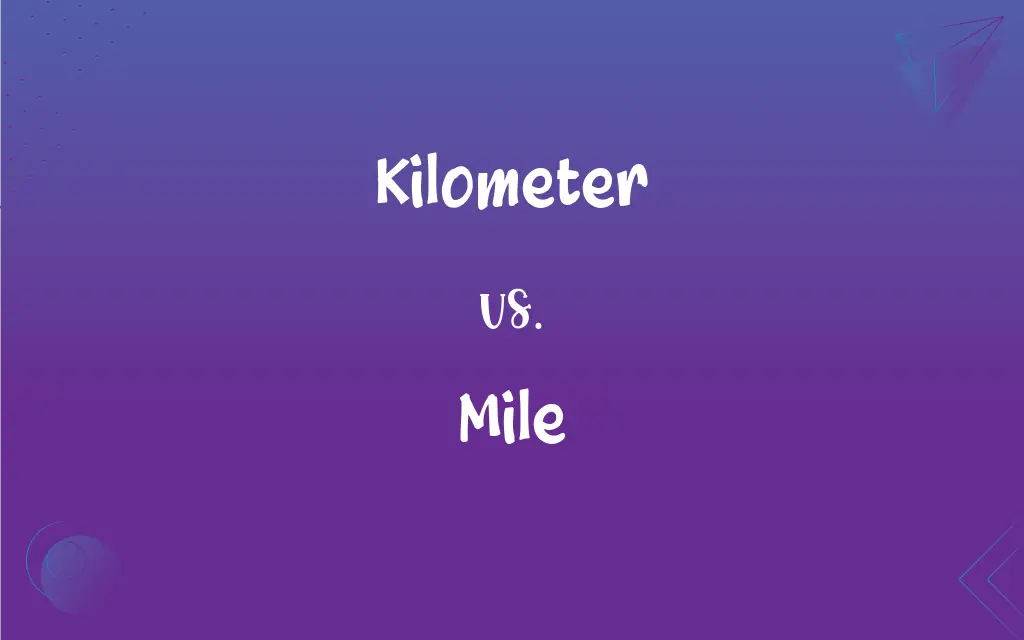Kilometer vs. Mile: What's the Difference?
Edited by Aimie Carlson || By Harlon Moss || Updated on October 5, 2023
A kilometer is a metric unit measuring 1,000 meters, while a mile is an imperial unit equal to 5,280 feet or 1.60934 kilometers.

Key Differences
A kilometer, often abbreviated as "km," is a unit of distance used primarily in the metric system, which is adopted by most countries worldwide. On the other hand, a mile is an imperial unit and is predominantly used in the United States, the UK, and a few other regions.
A kilometer represents a length of 1,000 meters, stemming from the metric system's base-10 nature, which is rooted in scientific measurements and global standardization. Conversely, a mile measures 5,280 feet, originating from the ancient Roman "mille passus," meaning "a thousand paces."
While a kilometer provides a round number within the metric system, facilitating quick mental calculations, the division of a mile into feet, yards, and inches can be more intricate. The mile's historical significance is deeply embedded in the cultures of countries that utilize it.
The conversion between kilometers and miles is often essential, especially in global communications and travel. While one mile equates to approximately 1.60934 kilometers, a round figure like 1.6 kilometers is sometimes used for simplicity. Both kilometers and miles play pivotal roles in transportation, sports, and many other fields.
Comparison Chart
System of Measurement
Metric
Imperial
ADVERTISEMENT
Length
1,000 meters
5,280 feet
Origin
Metric system (base-10)
Roman "mille passus" (a thousand paces)
Predominant Use
Most countries worldwide
United States, UK, and a few others
Kilometer and Mile Definitions
Kilometer
A measurement used in metric countries for transportation and sports.
The athlete ran ten kilometers in under 30 minutes.
Mile
An imperial unit equal to 5,280 feet.
The next town is ten miles away.
ADVERTISEMENT
Kilometer
A universally recognized metric distance measure.
The gas station is just two kilometers down this road.
Mile
A unit of length originating from the Roman "mille passus."
The car gets 30 miles per gallon.
Kilometer
A metric unit representing 1,000 meters.
The city center is five kilometers away.
Mile
A distance measure deeply rooted in American and British cultures.
He walks a mile to work every day.
Kilometer
A unit equivalent to 0.621371 miles.
The park covers an area of 3 square kilometers.
Mile
A unit often used in U.S. transportation, sports, and aviation.
The pilot reported the airport was 20 miles ahead.
Kilometer
A standard measure in the metric system for distance.
The marathon is 42.195 kilometers long.
Mile
A measurement equivalent to 1.60934 kilometers.
The trail extends for five miles through the forest.
Kilometer
A metric unit of length equal to 1,000 meters (0.62 mile). See Table at measurement.
Mile
Abbr. mi. or mi A unit of length equal to 5,280 feet or 1,760 yards (1,609 meters), used in the United States and other English-speaking countries. Also called land mile, statute mile. See Table at measurement.
Kilometer
Alternative spelling of kilometre
Mile
A nautical mile.
Kilometer
A measure of length, being a thousand meters. It is equal to 3,280.84 feet, or 0.62137119 of a mile.
Mile
An air mile.
Kilometer
A metric unit of length equal to 1000 meters (or 0.621371 miles)
FAQs
Where did the mile originate?
The mile originated from the ancient Roman "mille passus," meaning "a thousand paces."
How do you convert kilometers to miles?
Multiply the number of kilometers by 0.621371 to convert to miles.
What is a kilometer based on?
A kilometer is based on the metric system and represents 1,000 meters.
How many kilometers are in a mile?
There are approximately 1.60934 kilometers in a mile.
How many feet are there in a mile?
There are 5,280 feet in a mile.
Is a mile longer than a kilometer?
Yes, a mile is longer than a kilometer.
How does a 5K race relate to miles?
A 5K race is approximately 3.107 miles long.
Are kilometers and miles used interchangeably?
While they both measure distance, they belong to different systems and aren't used interchangeably without conversion.
Why do some countries have road signs in both kilometers and miles?
Some countries use both for the convenience of foreign drivers or due to historical ties with countries using different systems.
Which is more precise, a kilometer or a mile?
Both are precise in their respective systems, but the metric system (kilometers) is base-10, making calculations simpler.
Which countries primarily use kilometers?
Most countries worldwide use kilometers as part of the metric system.
How do speed limits differ in kilometer-based and mile-based countries?
Speed limits are generally given in kilometers per hour (kph) in metric countries and miles per hour (mph) in imperial-based countries.
Are nautical miles the same as standard miles?
No, a nautical mile is based on Earth's circumference and is equal to 1.852 kilometers or 1.15078 standard miles.
How does the aviation industry measure distance?
The aviation industry typically uses nautical miles.
What's the abbreviation for kilometer and mile?
"Km" for kilometer and "mi" for mile.
How many meters make up a kilometer?
A kilometer comprises 1,000 meters.
What are common mile markers in marathons?
Common mile markers in marathons include the 5, 10, 15, 20, and 26.2-mile points.
Why does the U.S. use miles instead of kilometers?
The U.S. historically adopted the imperial system, which includes miles, and hasn't fully transitioned to the metric system.
Which is used more in scientific research, kilometers or miles?
Kilometers, being part of the metric system, are more commonly used in scientific research.
How is fuel efficiency measured using kilometers and miles?
In metric countries, it's liters per 100 kilometers, while in the U.S., it's miles per gallon.
About Author
Written by
Harlon MossHarlon is a seasoned quality moderator and accomplished content writer for Difference Wiki. An alumnus of the prestigious University of California, he earned his degree in Computer Science. Leveraging his academic background, Harlon brings a meticulous and informed perspective to his work, ensuring content accuracy and excellence.
Edited by
Aimie CarlsonAimie Carlson, holding a master's degree in English literature, is a fervent English language enthusiast. She lends her writing talents to Difference Wiki, a prominent website that specializes in comparisons, offering readers insightful analyses that both captivate and inform.
































































